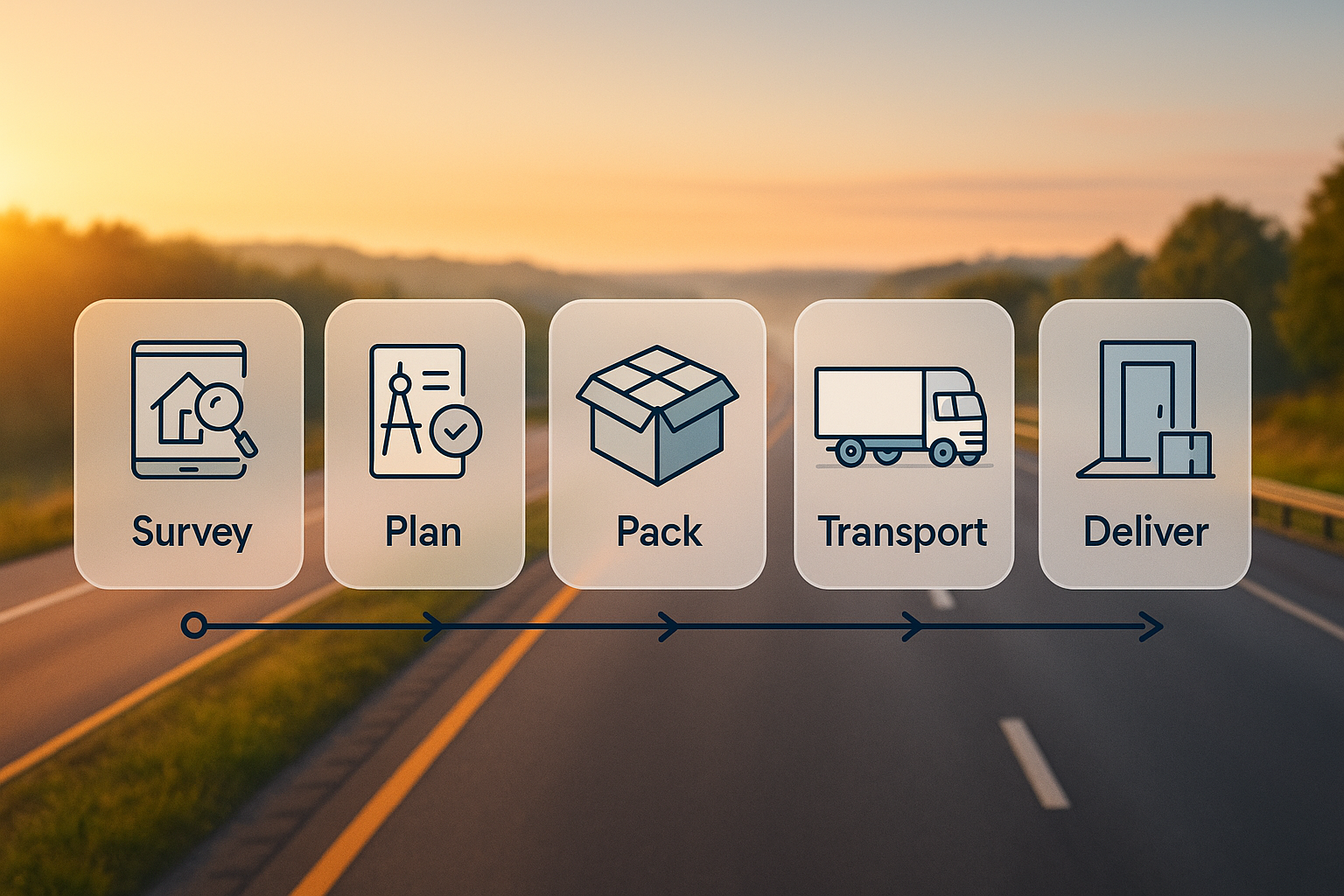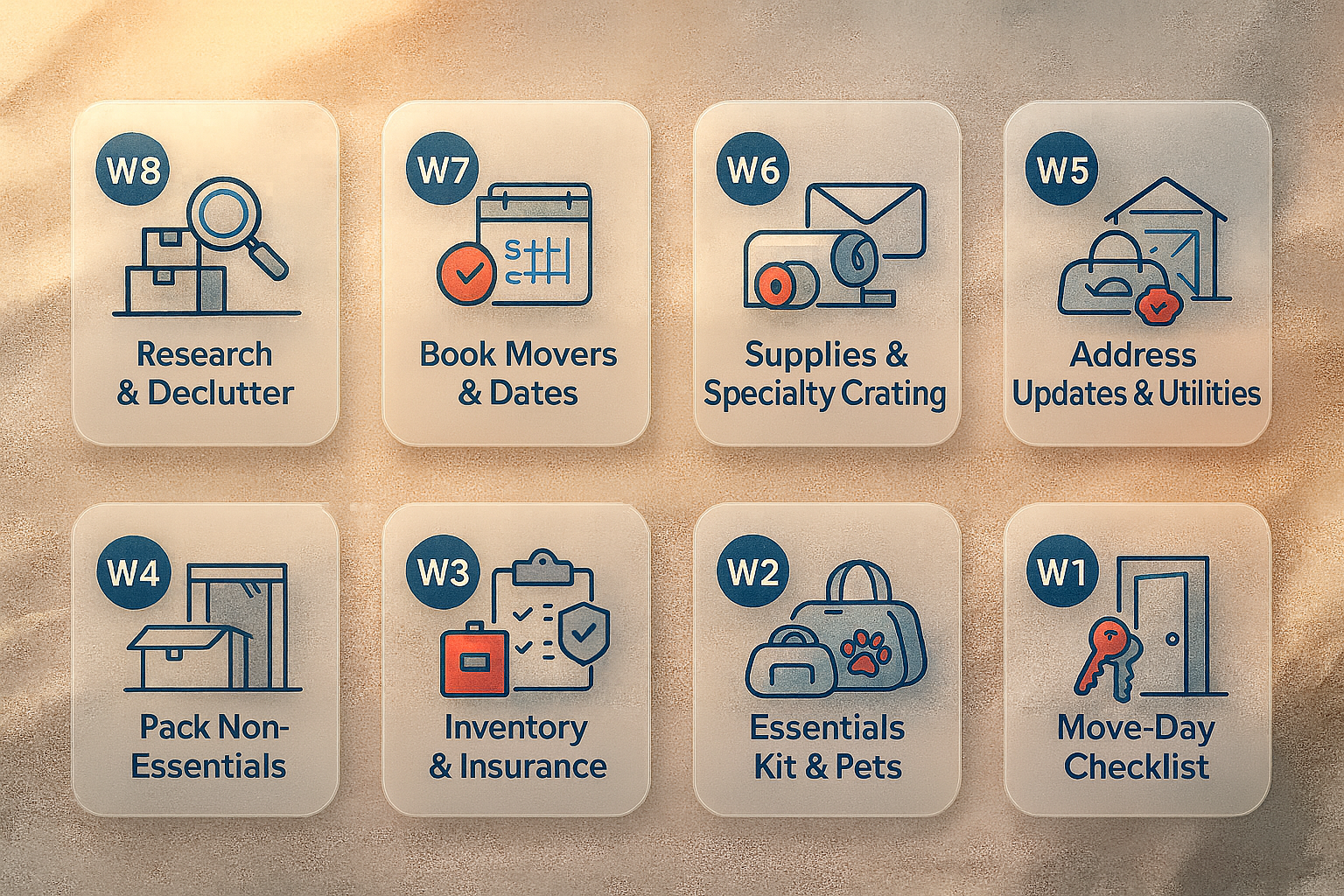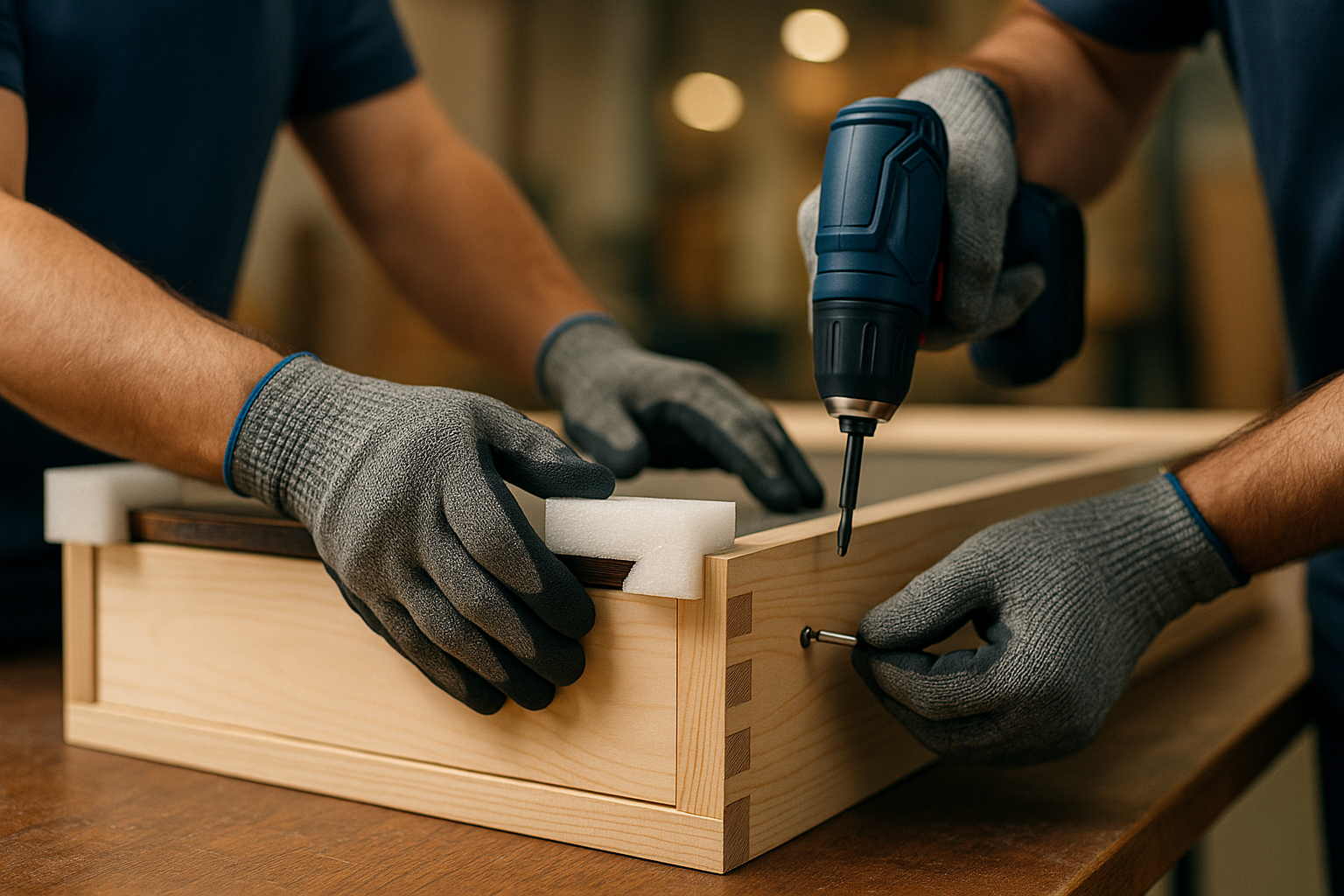Long-Haul Moving Services (2025): The Stress-Less, Step-By-Step Guide
Everything you need to plan an interstate or cross-country move: timeline, packing checklists, regulations, valuation coverage, special items, and pro tips from America First Moving.
How to plan a long-haul move (5 quick steps)
- Pick a licensed interstate mover and schedule a virtual/in-home survey.
- Create a 8-week timeline: purge, inventory, and book dates.
- Choose services (packing, crating, storage, auto/pet transport) and valuation coverage.
- Label by room; pack essentials; confirm loading, parking, and elevator access.
- On delivery, check the inventory, note exceptions, and sign only after review.

What “Long-Haul” Means (and how pricing works)
Movers use “long-haul,” “long distance,” “interstate,” and “cross-country” in slightly different ways. Practically, if your shipment travels hundreds of miles—especially across state lines—it’s long-haul. Interstate moves are regulated at the federal level, including consumer disclosures and valuation options. (FMCSA)
How estimates are built
- Weight/volume: Your survey (virtual or in-home) drives the weight estimate.
- Distance & route: Longer routes, remote access, and ferry/bridge tolls can affect pricing.
- Services: full or partial packing, unpacking, custom crating, storage, pet transport, and expedited shipping.
- Access: Long carries, stairs, elevators, or shuttle truck needs (tight streets/garages).
- Timing: Peak season (late spring–summer) and weekend pickups may price higher.
About “cost ranges”: actual prices vary widely by weight, distance, and services. There is no official government price benchmark for long-haul moves; use a professional survey and written estimate to get an accurate number. We’ll show you how to compare quotes apples-to-apples below.
Explore AFM Long-Haul Moving Services — transparent planning, licensed crews, and coast-to-coast coverage.

Your 8-Week Timeline
8–6 weeks out
- Book surveys and compare written estimates; confirm valuation options (see below).
- Purge: donate, sell, recycle—reduces weight and cost.
- Decide on full-service vs. hybrid vs. DIY packing.
- Measure doorways/halls; flag oversized items (piano, safe, artwork) for specialty crating.
5–4 weeks out
- Inventory by room; color-code labels.
- Order supplies (double-wall dish boxes, wardrobe boxes, glass packs).
- Request building forms (COI) and reserve elevator/parking at both ends.
- Start change-of-address and forwarding with the USPS (official COA).
3–2 weeks out
- Confirm dates, window, and phone numbers with your coordinator.
- Empty fuel from mowers/equipment; defrost and dry refrigerators 24–48h prior.
- Pack an “open-first” box: meds, documents, chargers, basic tools, linens.
Final week
- Photograph high-value items; note pre-existing wear.
- Set aside passports, jewelry, firearms, cash—carry personally.
- Walk the path; protect floors/walls; clear snow/ice or leaves.
Moving day
- Walk-through with the crew; confirm inventory tagging and special-care notes.
- Verify Bill of Lading details, contact info, and valuation coverage selection.
- Before the truck departs, confirm destination address, parking, and ETA window.
Delivery day
- Check off each item from the inventory; note exceptions before signing the delivery receipt.
- Assemble beds and set up a safe walkway; keep kids/pets secure.
Grab our printable checklist and stay on track from week 8 to move-in day.
Interstate Regulations, Paperwork & Valuation Coverage
Interstate household moves are overseen by the Federal Motor Carrier Safety Administration (FMCSA). Carriers must provide you with the Your Rights and Responsibilities When You Move booklet and the Ready to Move brochure before your move. These explain estimates (binding/non-binding), the Bill of Lading, pickup/delivery windows, and what to do if there’s loss or damage. See the official consumer hub at ProtectYourMove.gov.
Key documents you’ll see
- Estimate: binding, non-binding, or binding-not-to-exceed; check services/weight.
- Order for Service & Bill of Lading: dates, addresses, and liability terms.
- Inventory: numbered tags with condition notations.
Valuation coverage (not the same as insurance)
- Released Value (basic): typically $0.60 per pound per article (no extra charge).
- Full-Value Protection (FVP): carrier repairs, replaces, or pays current value (deductible options). Review exclusions and high-value items listing requirements.
Want a walkthrough? Ask your AFM coordinator to explain coverage choices side-by-side and help you document any items that need special listing.
See all AFM services and build your long-haul plan.
How to Choose a Reputable Mover (and avoid scams)
- Verify DOT/MC status: Search the company on ProtectYourMove.gov to confirm registration and complaint history.
- Demand a survey: Virtual or in-home; beware of sight-unseen “guarantees.”
- Compare apples-to-apples: weight, services, packing, access, shuttle, storage, valuation coverage, and delivery window.
- Read the estimate language: is it binding, non-binding, or guaranteed-not-to-exceed?
- Ask about claims process & timelines: who handles it and how to submit evidence.
America First Moving is fully licensed and provides transparent documentation before any commitment. We align our process to FMCSA’s consumer-protection rules so you know exactly what to expect at every step.

Packing Game Plan: Rooms, fragile items & specialty crating
Good packing prevents claims and delays. Decide early whether to self-pack, go partial, or choose full service. Our professional packing team can handle china, glass, artwork, and electronics, while you pack linens, books, and clothing.
Room-by-room pointers
- Kitchen: double-wall dish barrels; vertical plates; isolate knives; tape “This Side Up.”
- Living room: remove TV bases; save screws in labeled bags; wrap frames with corner guards.
- Bedrooms: wardrobe boxes; keep a “first-night” bag.
- Garage/outdoors: drain fuel; clean grills; bundle long-handle tools.
Specialty items
Pianos, glass tops, statuary, and fine art often require custom wooden crates. Your surveyor will measure and recommend the right protection so items ride safely over long distances.
Unpacking options
Prefer a faster settle-in? Add unpacking services at destination—carton removal and basic setup accelerate move-in day.
Cars, Pets & Temperature-Sensitive Items
Autos & motorcycles
Long-haul moves can include car or bike transport on the same work order. Ask about covered vs. open carriers and scheduling relative to household goods pickup. AFM can coordinate vehicle transport so timelines align.
Pets
Moving with furry family members? Our pet transport service prioritizes safe, humane travel. On moving day, plan a quiet, climate-controlled space away from doors.
Temperature-sensitive goods
Wine, musical instruments, candles, cosmetics, and some electronics can be damaged by heat/cold swings. Consider temperature-controlled storage as a buffer if your new home isn’t ready on delivery day.
Access, Parking, Permits & Weather
Every origin/destination is unique. Urban streets, gated communities, or tight mountain roads may require a smaller “shuttle” truck. Reserve loading zones/elevators as needed and request building Certificates of Insurance (COIs).
Seasonally, plan around severe weather and hurricane season in coastal regions (official Atlantic season runs June–November). Build date flexibility and ask your coordinator about contingency plans if storms threaten the route.
Need a tighter delivery window? Ask about expedited options on select lanes.
Delivery Day: Inventory, claims & post-move tasks
- Meet the crew and review the first items off the truck to set placement expectations.
- Check off each numbered tag on the inventory. Note any exceptions or carton damage in writing on the delivery receipt before you sign.
- Assemble beds and connect essentials first (fridge, Wi-Fi, lamps).
- Keep packing materials for a few days; schedule a debris pickup if included.
- If you need to file a claim, your AFM coordinator will guide you on documentation and timelines.
Talk to AFM about a full-service, headache-free move—from survey to settle-in.



